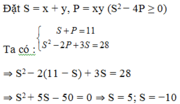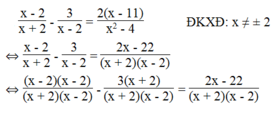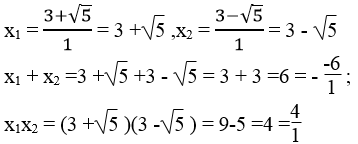Giải hệ phươngtrinhf
x4+11x2=3x2+9
Hãy nhập câu hỏi của bạn vào đây, nếu là tài khoản VIP, bạn sẽ được ưu tiên trả lời.


Bài 2:
a: =>2x^2-4x+1=x^2+x+5
=>x^2-5x-4=0
=>\(x=\dfrac{5\pm\sqrt{41}}{2}\)
b: =>11x^2-14x-12=3x^2+4x-7
=>8x^2-18x-5=0
=>x=5/2 hoặc x=-1/4

a. (3x - 1)2 - (x + 3)2 = 0
\(\Leftrightarrow\left(3x-1+x+3\right)\left(3x-1-x-3\right)=0\)
\(\Leftrightarrow\left(4x+2\right)\left(2x-4\right)=0\)
\(\Leftrightarrow4x+2=0\) hoặc \(2x-4=0\)
1. \(4x+2=0\Leftrightarrow4x=-2\Leftrightarrow x=-\dfrac{1}{2}\)
2. \(2x-4=0\Leftrightarrow2x=4\Leftrightarrow x=2\)
S=\(\left\{-\dfrac{1}{2};2\right\}\)
b. \(x^3=\dfrac{x}{49}\)
\(\Leftrightarrow49x^3=x\)
\(\Leftrightarrow49x^3-x=0\)
\(\Leftrightarrow x\left(49x^2-1\right)=0\)
\(\Leftrightarrow x\left(7x+1\right)\left(7x-1\right)=0\)
\(\Leftrightarrow x=0\) hoặc \(7x+1=0\) hoặc \(7x-1=0\)
1. x=0
2. \(7x+1=0\Leftrightarrow7x=-1\Leftrightarrow x=-\dfrac{1}{7}\)
3. \(7x-1=0\Leftrightarrow7x=1\Leftrightarrow x=\dfrac{1}{7}\)


Khi S = 5 ⇒ P = 6 thì x, y là nghiệm của phương trình
![]()
Khi S = −10 ⇒ P = 21 thì x, y là nghiệm của phương trình
![]()
Vậy hệ có nghiệm (3; 2), (2; 3), (−3; −7), (−7; −3).
Đáp án cần chọn là: D

2 x − y = 3 x 2 + y = 5 ⇔ x 2 + 2 x = 8 2 x − y = 3 ⇔ x 2 + 2 x − 8 = 0 ( 1 ) y = 2 x − 3 ( 2 )
Giải (1): Δ ' = 9 ; x 1 = 2 , x 2 = − 4
Thay vào (2): Với x = 2 t h ì y = 2.2 − 3 = 1
Với x = − 4 t h ì y = 2. ( − 4 ) − 3 = − 11
Vậy nghiệm của hệ phương trình là: x , y ∈ 2 ; 1 , − 4 ; − 11

a) \(\left\{{}\begin{matrix}2x+3y=-5\\6x-5y=27\end{matrix}\right.\) \(\Leftrightarrow\left\{{}\begin{matrix}6x+9y=-15\\6x-5y=27\end{matrix}\right.\) \(\Leftrightarrow\left\{{}\begin{matrix}14y=-42\\2x+3y=-5\end{matrix}\right.\) \(\Leftrightarrow\left\{{}\begin{matrix}y=-3\\2x+3.\left(-3\right)=-5\end{matrix}\right.\) \(\Leftrightarrow\left\{{}\begin{matrix}y=-3\\2x-9=-5\end{matrix}\right.\) \(\Leftrightarrow\left\{{}\begin{matrix}y=-3\\2x=4\end{matrix}\right.\) \(\Leftrightarrow\left\{{}\begin{matrix}y=-3\\x=2\end{matrix}\right.\)
Vậy phương trình có nghiệm là: \(\left\{{}\begin{matrix}y=-3\\x=2\end{matrix}\right.\)
b) \(3x^2+4x=0\)
\(\Leftrightarrow x\left(3x+4\right)=0\)
\(\Leftrightarrow\left[{}\begin{matrix}x=0\\3x+4=0\end{matrix}\right.\) \(\Leftrightarrow\left[{}\begin{matrix}x=0\\x=-\dfrac{4}{3}\end{matrix}\right.\)
Vậy phương trình có tập nghiệm là: \(S=\left\{0;-\dfrac{4}{3}\right\}\)
c) Đặt: \(x^2=t\left(t\ge0\right)\)
\(\Rightarrow\) Ta có phương trình mới:
\(t^2-3t-4=0\)
Ta có: a - b + c = 1 + 3 - 4 = 0
\(\Rightarrow t_1=-1\left(loại\right);t_2=4\left(TM\right)\)
\(\Rightarrow x=\pm2\)
Vậy tập nghiệm của phương trình là: S = {2; -2}
a, \(\left\{{}\begin{matrix}2x+3y=-5\\6x-5y=27\end{matrix}\right.\Leftrightarrow\left\{{}\begin{matrix}6x+9y=-15\left(1\right)\\6x-5y=27\left(2\right)\end{matrix}\right.\)
Lấy (1) - (2) ta được : \(14y=-15-27=-42\Leftrightarrow y=-3\)
\(\Rightarrow6x-27=-15\Leftrightarrow6x=12\Leftrightarrow x=2\)
Vậy \(\left(x;y\right)=\left(2;-3\right)\)
b, \(3x^2+4x=0\Leftrightarrow x\left(3x+4\right)=0\Leftrightarrow x=0;x=-\dfrac{4}{3}\)
c, \(x^4-3x^2-4=0\Leftrightarrow x^4+x^2-4x^2-4=0\)
\(\Leftrightarrow x^2\left(x^2-4\right)+x^2-4=0\Leftrightarrow\left(x^2+1\right)\left(x-2\right)\left(x+2\right)=0\)
\(\Leftrightarrow x=\pm2;x^2+1>0\)
Vậy nghiệm của phương trình là x = -2 ; x = 2

Phương trình 5x2 + 2x -16 =0 có hệ số a=5 ,b=2 c=-16
Ta có: Δ'=12 -5(-16) = 1 + 80 =81 >0
Δ' = 81 =9
Phương trình 3x2 -2x -5 =0 có hệ số a =3,b = -2, c = -5
Ta có: Δ'=(-1)2 -3(-5) = 1 + 15 =16 >0
Δ' = 16 =4
Phương trình 
Δ'=32 -1(-16) = 9 +16 =25 > 0
Δ' = 25 =5
Phương trình 
Ta có: Δ'=(-3)2 -1.4 = 9 -4 =5 >0
Δ' = 5



⇔ (x – 2)(x – 2) – 3(x + 2) = 2x – 22
⇔ x 2 – 2x – 2x + 4 – 3x – 6 = 2x – 22
⇔ x 2 – 2x – 2x – 3x – 2x + 4 – 6 + 22 = 0
⇔ x 2 – 9x + 20 = 0
⇔ x 2 – 5x – 4x + 20 = 0
⇔ x(x – 5) – 4(x – 5) = 0
⇔ (x – 4)(x – 5) = 0
⇔ x – 4 = 0 hoặc x – 5 = 0
x – 4 = 0 ⇔ x = 4
x – 5 = 0 ⇔ x = 5
Vậy phương trình có nghiệm x = 4 hoặc x = 5.






<=>\(x^4-8x^2-9=0\)
đặt \(t=x^2\left(t\ge0\right)\)
pt thành \(t^2-8t-9=0\)
<=>\(\left(t+1\right)\left(t-9\right)\)
<=>\(\left[{}\begin{matrix}t=-1\\t=9\end{matrix}\right.\)
so với đk của t=>t=9
vậy \(x^2=9\)
<=>x=\(\pm9\)